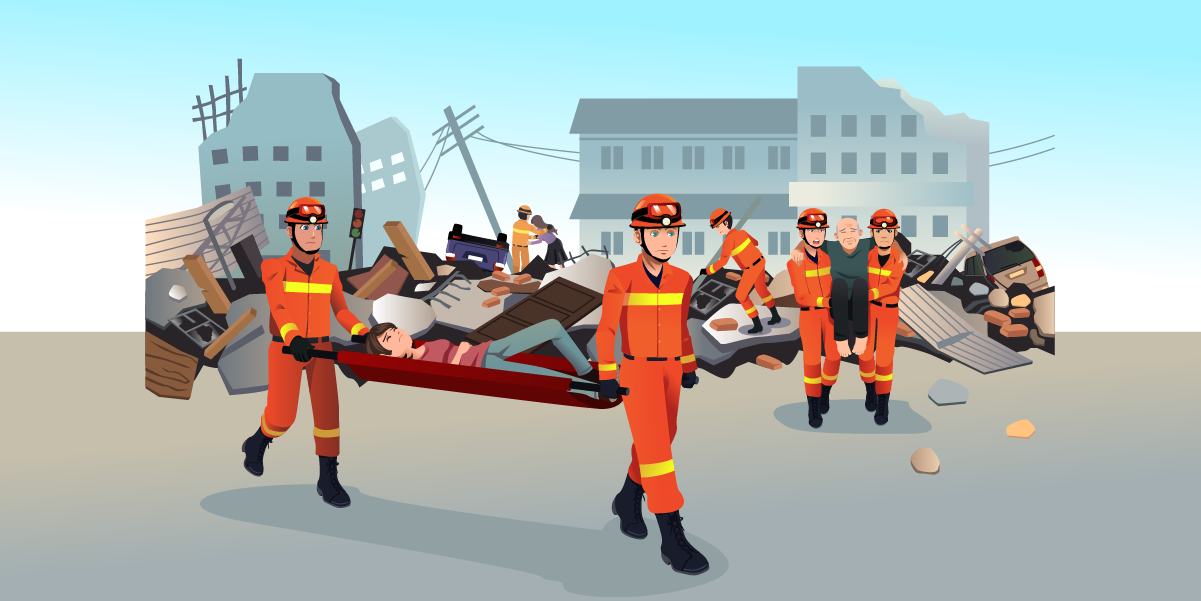Mon-Sat 9am-7pm








Disaster Management Specialists work in teams to restore and remove pollution and contaminants from soil and water, or to address engineering issues after a disaster. Contracts vary from single dwellings to entire countries struck by disaster. Balancing quick action with careful planning, knowledge of the area and scope of the disaster, disaster management specialist teams use a number of channels to undue the damage that was caused. While the job varies wildly from contract to contract, most specialists will have the following roles in common:

There are 2 ways
Career Path 1
Student can do 12-Any stream. Then complete B.A. / B.Sc (Any field). Further you can Proceed with MBA in Disaster Management. Further you can Proceed with Ph.D. in Disaster Management.
Career Path 2
Student can do 12-Any stream. Then complete B.A. / B.Sc. Further you can Proceed with P.G Diploma in Disaster Management. Further you can Proceed with Certification Programs of Disaster Management.
The U.S. Bureau of Labor Statistics (BLS) reported that disaster management specialists, who fall under the broader BLS category of environmental scientists and specialists, earned a median salary of $73,230 as of May 2020. The highest paid work for the federal government, which reported a median salary of $103,180 during this time.*
Government and non-government organisations have their own salary packages, which is based on the industry standards At an entry level, one can earn around Rs 8,000 - Rs 10,000 per month Candidates with 2 or 3 year's experience can easily earn between Rs 15,000 - 20,000 per month Well experienced candidates can draw up to Rs 1,50,000 per month
Read more at: https://www.careerindia.com/courses/unique-courses/what-is-disaster-management-scope-career-opportunities-015399.html
During disasters, a crisis is an acute event that is fast moving and changing. Therefore, effective emergency planning and response is vital. A lack of coordination and response to disasters can have serious and long-lasting impacts on a community and can also lead to more deaths. Disaster management can help to enhance the ability of emergency responders to save lives. When appropriate infrastructure is set up and training is completed to improve disaster response, communities can survive the stress and distress caused by disasters.
When disaster strikes, response teams have the unenviable task of trying to help people in extreme conditions. The task can be extremely tough as an unprepared and untrained response team will have limited knowledge of the people they are working with. However, training helps to improve the effectiveness of a disaster management response team. Having the skills needed to help people in extreme conditions is one of the key elements of disaster management training.
Disasters cause an enormous number of deaths. However, they also create an additional health risk to those affected. People affected by disasters are frequently exposed to a range of illnesses which can cause further death. Communicable diseases, such as malaria, are much more likely to occur during and after a disaster because a lack of healthcare facilities, clean water, food and proper hygiene is common. Through disaster management practices, communities can improve their health and mitigate the impact of disasters.
A natural disaster can have devastating effects on a community. It can push people into poverty and change the lives of entire communities. However, a lot of people affected by a disaster are more likely to stay poor if they are not prepared. A lack of planning prior to a disaster can leave people without basic emergency supplies like food, water, clothing or medicine. By better preparing for disasters, communities can mitigate the threat of poverty, hunger and disease.
Disasters, along with their aftermaths, can have a negative effect on a community’s health. Disasters, along with lack of health services and clean water can lead to increased sickness, lack of immunity and a higher risk of infection. Therefore, it is essential that communities have access to health professionals, have a good supply of water and adequate sanitation facilities, and have access to emergency medical care during and after a disaster.
Disasters can have a huge impact on the local economy. Communities often suffer huge financial losses during a disaster and therefore may struggle to cope with these losses. A disaster can also impact the social fabric of a community. In this way, disaster management can help communities rebuild their communities and reconnect people with each other. Communities can begin to rebuild their local infrastructure after a disaster, which will also improve the economic health of a community. In many cases, this will benefit the economy as a whole, while also improving the environment in which people live.
Terrorist groups exploit disasters to cause further bloodshed and chaos. The causes and consequences of disasters can act as a magnet for people with bad intentions to commit acts of terrorism. There are some social conditions which make terrorist activities more likely in certain areas. Examples include poor governance, overcrowding and high levels of poverty. After a disaster, communities must be vigilant in the protection of their security.
Disasters can disrupt social order, economic activity, and the flow of trade. At their worst, disasters can create insecurity, mistrust, ethnic tensions, hatred and violence. These conflicts, if not addressed, can negatively impact the stability of communities and the effectiveness of local security forces. After a disaster, people who would normally rely on law enforcement agencies to provide security are likely to turn to alternative sources of law and order. This may increase the amount of crime and violence which takes place.
Disasters can be devastating to the lives of people living in an area and can cause environmental degradation. If a disaster negatively affects the environment or local ecosystems, it may also lead to species extinctions, loss of indigenous knowledge, and the general destruction of entire ecosystems. At the same time, disasters can also have a detrimental impact on the social and economic structure of a community, leaving it vulnerable to social instability and human trafficking. Communities must plan for disasters and work to secure their natural resources to ensure they are prepared for the next disaster.
Disasters can undermine social and political stability. Governments, large corporations and other important organisations often fail to provide people with protection during or after a disaster, which can lead to increasing social inequalities, distrust, hostility and violence. This, in turn, can lead to weaker social institutions and increased individual susceptibility to aggression and coercion.
In some cases, people may turn to other forms of authority to solve their problems. This could lead to the creation of groups which exploit these inequalities and disadvantage people in certain areas. This may be reinforced by large corporations or other institutions which lack accountability. In turn, this can weaken democracy and lead to increased inequality and deprivation.
:Disaster management is limited by the availability of appropriate resources, either human or material, because a disaster overwhelms the capacity of the affected area to respond to the needs it generates.
In the case of natural disasters, it may be impossible to bring resources to bear on the situation because the natural environment is too dangerous for responders to function inside of it until the force of the event subsides enough to allow them access. During severe weather events, responders are as much at risk as the general population and are as limited in their movement as everyone else is limited.
Supply chain issues also limit responses. If the situation demands a certain number of items and there are not enough of them and more will not be forthcoming for some critical amount of time, the allocation of those resources will be limited to those in greatest need and who can benefit from having them.
One of the most common misconceptions about disasters is that CPR will be a skill that is in high demand. Those who know CPR, know that the care giver does not stop the process once it has begun unless the patient has responded positively or the care giver becomes too tired to continue providing care. Without access to advanced life support technology and/or additional trained personnel, the process cannot be sustained.
Similarly, patients who are not likely to recover will not be prioritized for care as long as there are other patients whose conditions will worsen if care is withheld from them while critical cases are prioritized. It is a heartbreaking reality, but there it is. The most severely injured are made as comfortable as they can be under the circumstances while responders focus on the next level of patient below that level of severity in the effort to keep them from becoming worse off.
Other limitations come from the levels of responders above the ones within the affected area. If there are not sufficient resources available at the next level up, for example the county which is larger than the city, then the help that is needed is not going to be available for some time. If the county is slow to respond for any reason, the city will suffer as a result of that condition.
Lack of trained and equipped responders is a limitation. Similarly, the inability to move people and goods to and through the affected area is a limitation. It takes time to stage a response effectively and that means there will be waiting time before resources arrive where they are needed.
Lack of support or hostility against the affected area will create limitations for effective management. If a higher authority believes that the affected area does not need or deserve assistance, it will be withheld. When areas are close to one another and equally affected, the distribution of resources will be necessary and competition for them will be high. Those who do not receive what they need will become resentful of those who withheld it from them in their time of need. Who else needs it? Where else is it needed?
Lack of imagination is also a limiting factor in disaster management. Once the traditional channels have been exhausted, there is a need to improvise the response effort. This can be very intimidating for people who are accustomed to having sufficient resources available to them on demand. Once those are not available, the responders may feel lost because they cannot rely on what they do routinely. This will slow the response time and hinder the responders’ efforts. Operating rooms are usually extremely well-lighted environments. If the power fails during surgery, will the surgical team be able to continue as effectively, especially as power may be rerouted to other places even when there are generators in use. On a simpler level, what will you do when you run out of sterile dressings at home or in the community? What will you use for a splint if you have to transport someone with a broken limb? What will you do for light if the environment might contain gas?
Lack of funding for response and recovery will hinder those activities and limit their effectiveness. If materials and personnel are not planned for and available, it will take time to find them and put them in place. During that time, lives and property will be lost.
A disaster is a disaster because it is overwhelming to begin with and being overwhelmed creates limitations from the onset of the event. The big issue is to be able to bring balance to the situation by meeting its demands as quickly as possible for as many as it is possible to serve.
Call us at +91 9205084085, Monday - Friday, 9 am - 7 pm


